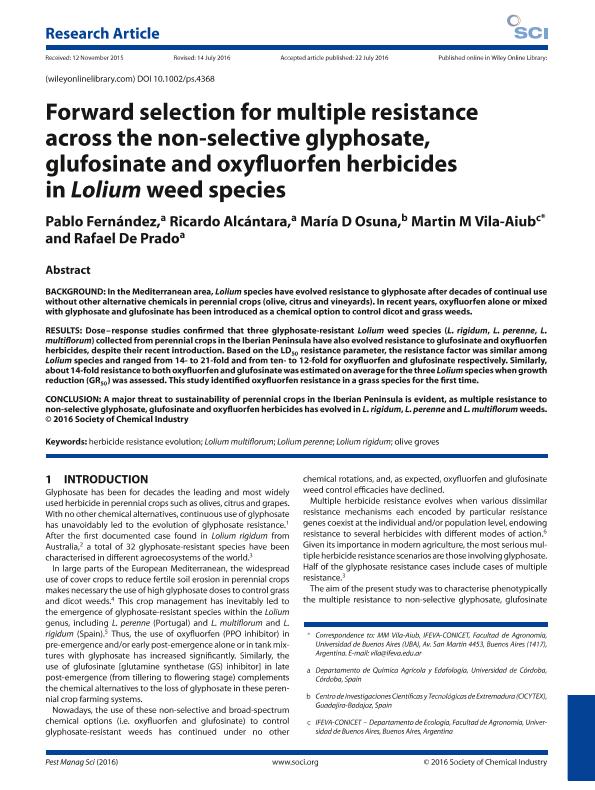Artículo
Forward selection for multiple resistance across the non-selective glyphosate, glufosinate and oxyfluorfen herbicides in Lolium weed species
Fecha de publicación:
05/2017
Editorial:
John Wiley & Sons Ltd
Revista:
Pest Management Science
ISSN:
1526-498X
Idioma:
Inglés
Tipo de recurso:
Artículo publicado
Clasificación temática:
Resumen
BACKGROUND: In the Mediterranean area, Lolium species have evolved resistance to glyphosate after decades of continual use without other alternative chemicals in perennial crops (olive, citrus and vineyards). In recent years, oxyfluorfen alone or mixed with glyphosate and glufosinate has been introduced as a chemical option to control dicot and grass weeds. RESULTS: Dose-response studies confirmed that three glyphosate-resistant Lolium weed species (L. rigidum, L. perenne, L. multiflorum) collected from perennial crops in the Iberian Peninsula have also evolved resistance to glufosinate and oxyfluorfen herbicides, despite their recent introduction. Based on the LD50 resistance parameter, the resistance factor was similar among Lolium species and ranged from 14- to 21-fold and from ten- to 12-fold for oxyfluorfen and glufosinate respectively. Similarly, about 14-fold resistance to both oxyfluorfen and glufosinate was estimated on average for the three Lolium species when growth reduction (GR50) was assessed. This study identified oxyfluorfen resistance in a grass species for the first time. CONCLUSION: A major threat to sustainability of perennial crops in the Iberian Peninsula is evident, as multiple resistance to non-selective glyphosate, glufosinate and oxyfluorfen herbicides has evolved in L. rigidum, L. perenne and L. multiflorum weeds.
Archivos asociados
Licencia
Identificadores
Colecciones
Articulos(IFEVA)
Articulos de INST.D/INV.FISIOLOGICAS Y ECO.VINCULADAS A L/AGRIC
Articulos de INST.D/INV.FISIOLOGICAS Y ECO.VINCULADAS A L/AGRIC
Citación
Fernández, Pablo; Alcántara, Ricardo; Osuna, María D; Vila Aiub, Martin Miguel; Prado, Rafael De; Forward selection for multiple resistance across the non-selective glyphosate, glufosinate and oxyfluorfen herbicides in Lolium weed species; John Wiley & Sons Ltd; Pest Management Science; 73; 5; 5-2017; 936-944
Compartir
Altmétricas




